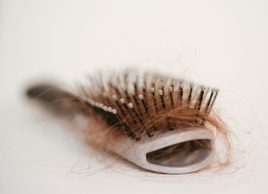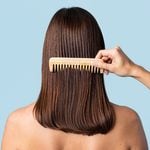“I lost all my hair to alopecia”
What would you do if you lost all your hair to alopecia? Read how one woman came to feel comfortable with going bald

Lise Carriére was shampooing her short blonde hair one morning in September 2009 when she realized a lot of it was coming out in her hands. ‘I’ve never been one to lose much hair, so I was really surprised,’ says the 46-year-old Vancouverite. She shrugged it off and headed to her busy job as planning manager of brand and creative services for the Vancouver Olympic Games organizing committee. The 2010 Olympics were only months away, and things were getting hectic.
In the weeks that followed, Lise’s hair continued to fall out at an alarming rate. ‘I had huge bald patches on both sides.’ Devastated, she hid her rapidly expanding baldness underneath hats while having to wait over a month to see a specialist. ‘I was constantly afraid my hat would fall off.’ She was diagnosed with alopecia areata. The specialist treated her by injecting her scalp with corticosteroids (a common alopecia treatment); the pain brought her to tears. ‘Don’t worry,’ she told him. ‘I’ve been doing a lot of crying lately anyway.’
What is Alopecia areata?
Alopecia areata, which can range from a small patch of hair loss to large areas of little or no hair, affects two percent of the population.That makes it as common as psoriasis, but it’s not nearly as well-known. Classified as an autoimmune disorder, it can be triggered by stress. ‘Deep in the hair follicle, an inflammatory reaction causes the hair to fall out,’ says Dr. Jeff Donovan, a specialist in hair diseases at Sunnybrook Health Sciences Centre in Toronto. ‘But the follicle remains active and can produce hair again. It just needs the right signal.’
Regrowth is unpredictable, however. ‘Some patients have regrowth within a year,’ says Donovan. ‘With others, it remains patchy.’ Even those who regain normal hair growth may lose it again later on. For some, hair loss can be a one-time occurrence, but for those affected in childhood (statistically half of those diagnosed), it can become chronic.
Treatment consists of medications to reduce inflammation and control the immune response, such as topical corticosteroids via lotions or creams, or injections of corticosteroids into the surface of the scalp (as Lise had), often in combination with hair restoration products such as minoxidil. Other, less common, treatments involve Botox, immunotherapy and laser therapy. ‘Response to treatment is difficult to predict and varies with patients,’ says Donovan.
The triggers
Lise believes stress is what likely triggered her hair loss: the emotional stress of coping with the sudden death of a colleague. She started losing her hair just 10 days later. ‘We worked together closely and had become good friends. He was only 39. It was a horrible shock.’
Stress is a recognized factor in many cases; scientists are not yet clear what role hormones might play. And contrary to some theories, no direct correlation has been found between vitamin D levels and alopecia. Eight percent of those with alopecia areata also have thyroid disease, though treatment for thyroid disease does not cure the alopecia.
Coping with life without hair
Professional counselling is helpful in learning to cope with the psychological and social impact, which can result in depression, job loss and even divorce. Children, in particular, are often subject to ostracism and ridicule by their peers.
Jim Makris, president and co-founder of the newly established Canadian Alopecia Areata Foundation, with support groups in B.C., Alberta and Manitoba, says people of all ages come to the foundation’s support group meetings. ‘We also hold clinics on ways to enhance appearance, such as wearing scarves and jewellery or choosing hats and makeup,’ he says. Members promote public awareness at schools and public functions, and the foundation maintains a social worker and medical advisor on its board.
A police officer for the city of Toronto, Makris says alopecia affects the entire family. ‘Everyone who knows and loves that person is affected by their hair loss.’ He speaks from experience: His 14-year-old daughter started to lose her hair at age four. With her parents’ guidance, she has learned how to live with her condition. She had eyebrows tattooed on a couple of years ago, and wears a custom-made natural hair replacement system.
Hair replacement didn’t appeal to Lise. ‘I tried on some wigs,’ ‘she says, ‘but I felt like I was playing dress-up.’ Plus, she says, it just didn’t fit into her lifestyle. ‘I swim, do hot yoga, run’. What would ‘I do with a wig or scarf?’ She was growing tired of wearing hats, so less than two weeks after her first treatment, she took a bold step’shaving her head completely. ‘I’ve known my hairdresser for a long time, so we made it a celebration, with wine and candles’the works!’ For Lise, it was kind of a goodbye party for her hair.
She loves her new look. ‘It’s a very personal decision, but letting go of my attachment to my hair was wonderful. It has proven to be a freeing experience.’ Lise’s choice was also economical. Purchasing wigs or sophisticated hair systems can cost up to $5,000, and requires regular maintenance and replacement every two years. Plus, working out at her lunch break is so much easier. ‘I can just rinse and go,’ she says.
Baldly proud
Statistics show that half of patients with adult-onset alopecia see hair regrowth within one year. Although Lise’s medication is producing good regrowth some 20 months after that first shock in the shower, there are still sparse patches above her forehead. ‘They’re too visible for me to grow my hair out.’ So she continues shaving it twice a week.
In fact, Lise now sports her bald head proudly, refusing to hide under a hat. ‘The question I’m asked most often is, ‘Do you have cancer?‘ I don’t mind; I’m just pleased that people care enough to ask.’ She agrees that shaving is not for everyone, and ‘sure,’ she says, ‘I have days when I wish I had my hair back. But for now I’m comfortable with my bald head.’
This article was originally titled "Bald can be beautiful," in the May 2011 issue of Best Health. Subscribe today to get the full Best Health experience’and never miss an issue!’and make sure to check out what’s new in the latest issue of Best Health.




